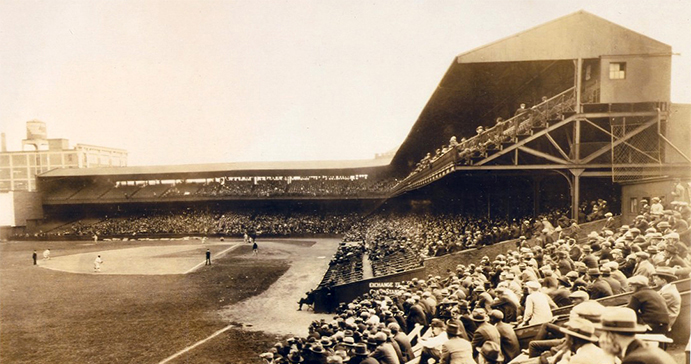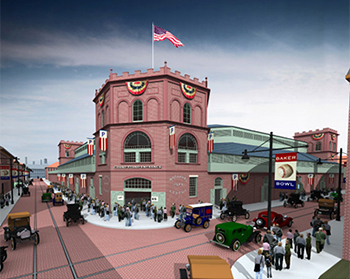The Ballparks
Baker Bowl
Philadelphia, Pennsylvania
(William Cash/Lloyd Thompson Collection—Courtesy of the African American Museum in Philadelphia)
It was a ballpark ahead of its time when built and well behind the times when abandoned 40 years later, by then a ridiculed dump given a slough of unpleasant names. Steel and concrete gave little comfort for the poor souls victimized in a series of unfortunate events—and as spectators covered their heads from debris, the right fielders covered theirs from the balls constantly ricocheting off the tall and cozily placed tin wall behind them. Welcome to Baker Bowl: Enter at your own risk.
It all began with a fire, like most new ballparks of the 20th Century’s infant days, rising from the ashes of their predecessors. For a few short years, the phoenix that would become Philadelphia’s Baker Bowl stood proud and tall as a centerpiece of cutting-edge ballpark architecture, jumping on the steel-and-concrete bandwagon a full decade before the rest of baseball began following suit. But its glory would be short-lived, its misery to follow seemingly eternal. It was designed to look like a castle, but as it aged without grace it certainly came across as medieval to those who played, watched and occasionally died upon its grounds.
Before Baker Bowl, at the intersection of North 15th and Huntingdon Streets, there was the Philadelphia Baseball Grounds—constructed in 1887 entirely out of wood and costing $80,000. At the time, it was considered baseball’s finest ballpark. The hitters who came to bat had a different point of view, looking distantly out at fences as far as 500 feet from home plate; some accounts say that the only home runs hit there were of the inside-the-park variety. Then one day, barely seven years after it had opened, the whole thing burned to the ground. Many of the Phillies were there preparing early for a game, but the fire was not their idea of warming up; some of them narrowly escaped with their lives. It was never officially determined what started it. Maybe the disgruntled hitters did it.
After the Fire.
In a rather amazing feat, the Phillies went into overdrive to quickly rebuild with three shifts of crews working day and night over 12 days to discard the cooling debris and prop up an interim facility with 9,000 seats. Just as quickly, team owner Alfred J. Reach started seeking a more permanent, more improved—and more fire-resistant—solution for a replacement ballpark. His interest led him to local architect John D. Allen, who specialized in theaters and “fire-proof work.” Allen doubled Reach’s pleasure; not only did he suggest a steel-and-concrete structure previously untried within baseball, but he also drew up a double-deck design using a cantilever process that eliminated the need for supporting posts that typically obscured the views of field-level fans (and still do today at Fenway Park and Wrigley Field).
The steely nature of the ballpark, which was first named Philadelphia National League Park, was lost on those who saw it as purely brick from the outside. The main entrance behind home plate was constructed in the shape of a castle, topped with turrets; all it needed was a drawbridge, knights at the door and lit torches to really send patrons back in time, but the Phillies weren’t thinking the way Walt Disney would a half-century later.
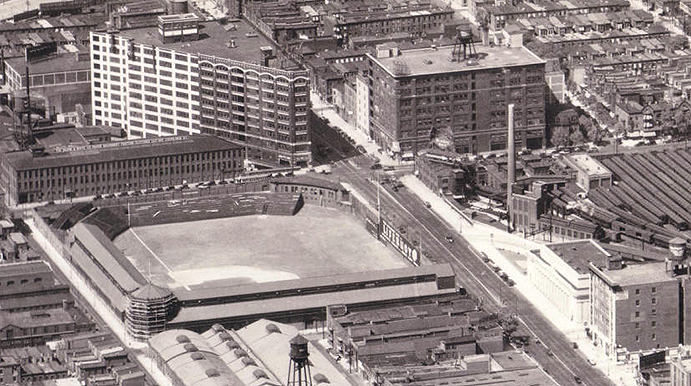
Baker Bowl circa 1931. Among the surrounding landmarks is the Reading Railroad yard (at right) and the triangular Ford Motor Company building—which remains standing today. (Hagley Digital Archives)
Baker Bowl’s double-deck structure would eventually stretch all the way down the right-field line and halfway down the left; from there, one level of uncovered bleachers would wrap around the left-field foul pole to the edge of center field, where they came to an abrupt end—leaving a gap of outfield extending across to the tall right-field wall. The Phillies once filled in that gap with temporary bleachers for the 1915 World Series to bring in more fans and, of course, make more money. The Phillies profited financially, but the visiting Boston Red Sox profited in the box score; in Game Five, the Red Sox’ Harry Hooper bounced two line drives into the added seats and were declared home runs per the ground rules of the time. The latter poke broke a 4-4, ninth-inning tie, and the Red Sox won the game and the series.
Behind center field lay the clubhouses for both the Phillies and their visitors in a multi-storied brick structure that had the appearance of a factory abutting the perimeter of the ballpark. No one ever hit a ball over the clubhouse, but in 1929 the great Rogers Hornsby lacerated a drive through one of its windows. A pool was eventually placed in the Phillies’ clubhouse and was put to good use. And bad: Phillies coach and long-time baseball eccentric Hughie Jennings once decided to take a head-first dive, but there was no water waiting for him. Perhaps the potential liability from such incidents gave the penurious Phillies second thoughts about the pool; by the end of World War I, it was removed.
There was also a bit of a rumble inside the clubhouse thanks to a series of railroad tracks that tunneled underneath. The center field gap was affected as well, slanting upward several feet above the rest of the field’s plain as a result of the underground egress, which ran diagonally beneath the northeast edge of the ballpark grounds. For this, Baker Bowl assumed one of its more lighthearted nicknames: “The Hump.”
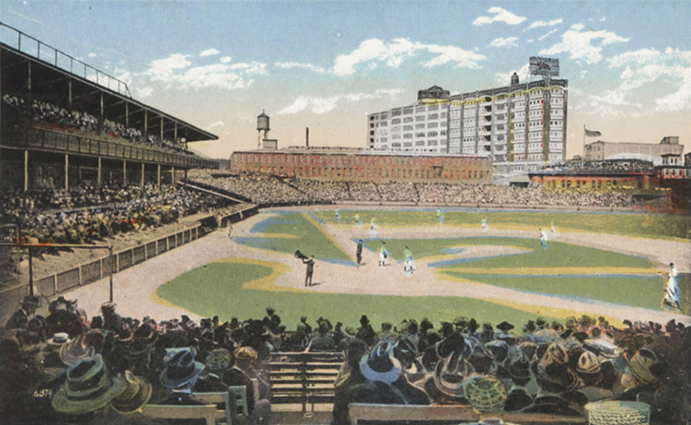
A postcard image for Baker Bowl. The man with the megaphone behind home plate stands in as the public address announcer; the ballpark never wired up a sound system.
There would be wood. All 20,000 seats were made from lumber, as were balcony-like planks that stuck out behind the grandstands and over the sidewalks 30 feet below. That led to another tragedy in 1903, this one having nothing to do with fire.
During the second game of a doubleheader, a pair of drunks was being teased by two ladies on the outside sidewalk. The guys didn’t like that; they attacked the girls. The commotion caught the attention of nearby fans within the ballpark, many of them hurrying atop the balcony to check it out. They were joined by more fans, then more, and then still more. Apparently, a 3-3 tie on the field was less enticing. The weight of humanity became too much for the planks, and the whole balcony gave way. Twelve people ended up dead and over 200 were injured—some of them permanently—in what was by far the highest casualty count related to a major league ballgame. The Phillies weaseled their way out of being sued and happily offered a lifetime of free admission to those hurt in the accident. It was like offering free pasta to a dining patron who nearly died of food poisoning eating the same dish a week earlier.
The collapse cast a pall over the relatively young ballpark that had opened eight years earlier to high acclaim. What followed was a volatile period of ownership that grounded the Phillies in the standings until William Baker bought the club in 1913 and held onto it for the long term. But Baker Bowl was not part of his long-term vision, even after he renamed the ballpark after himself (as many owners of the time did); he wanted to move six blocks west to Shibe Park, recently built for the Philadelphia Athletics. But the A’s refused to share concession profits with the Phillies and, more pointedly, Baker was chained with a 99-year lease on Baker Bowl (annual rent: $25,000), whose ownership was now in the hands of others. That the lease assumed the ballpark would make it through 2010 had to be considered something of a joke; at its rate of decay, it was going to be lucky to make it past 1930.
Giving Your Regards to Broad Street.
Perhaps Baker shared the concerns of his Phillies players—particularly the pitchers—over Baker Bowl’s tight field alignment. In a time when outfields across baseball were vast and spacious, Baker Bowl was a compact relative, easily the home of the majors’ smallest dimensions—a place that gave birth to the term “bandbox.” It was a normal 335 feet down the left-field line and 408 to the 35-foot-high brick clubhouse in the deepest part of center. But then there was right field, the source of the pitchers’ angst. With the presence of Broad Street restricting expansion, the field—and the ballpark with it—had to stop right up to its curb, a mere 280 feet from home plate as measured down the right-field line. The right-center power alley—at 300 feet—offered precious little relief. The New York Times’ Red Smith wrote: “If the right fielder had eaten onions at lunch the second baseman knew it.” Even little leaguers would have salivated over the wall’s cozy proximity.
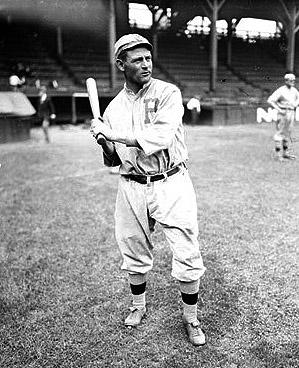
Gavvy Cravath was one of the first Phillies sluggers to take advantage of Baker Bowl’s cozily placed right-field wall. (Chicago Historical Society)
The great Pete Alexander was as astonishing at keeping opponents nailed down at Baker Bowl as Cravath was at disassembling them. In a remarkable three-year stretch from 1915-17, the Hall-of-Fame pitcher racked up 30-plus wins each year with earned run averages under 2.00; in 1916, he set an all-time record with 16 shutouts—nine of them at Baker Bowl. Right field was simply a non-issue for Alexander the Great.
A year earlier, when Alexander was at his absolute best—furnishing a 1.22 ERA and allowing just three homers (two at home) in 376 innings, Alexander won Game One of the World Series against the Red Sox at Baker Bowl, pitching a complete-game 3-1 victory. It would be the only World Series game the Phillies would ever win over their first 97 years of existence.
So Close, You Could Almost Touch it From Home Plate.
The ne plus ultra of Baker Bowl’s offensive madness would take place in 1930. The Phillies were lousy—they finished at 52-102—but you never would have known it from their potent hitting. In a year gone offensively mad in the NL, Baker Bowl went certifiably insane. The Phillies punctuated a .315 team batting average—the third highest in major league history—with an eye-popping .344 mark at home. The opponents did better. They hit .356. It all may have become too much for Phillies owner William Baker; he died of a heart attack after the season.
The Phillies’ undisputed matinee idol of the late 1920s and early 1930s was outfielder Chuck Klein, who took advantage of the right-field wall in multiple ways. During that crazy 1930 campaign, Klein hit .439, conked out 26 of his 40 homers and racked up 109 of his 170 RBIs at Baker Bowl. From his position playing in front of the right-field wall, Klein played so close to the infield—he had no choice—he set an all-time mark with 44 outfield assists.
Klein also was the guy who hit the longest home run in Baker Bowl history. Well, sort of. After easily clearing the right-field wall, a Klein home run ball bounced onto the railroad tracks across Broad Street, hitched a ride on a moving empty coal car and was discovered 60 miles away in Reading, Pennsylvania.
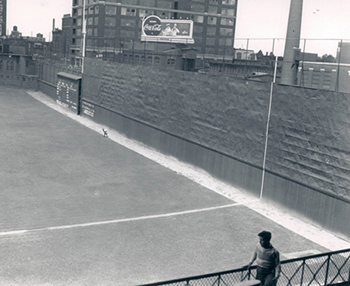
Baker Bowl’s 40-foot right-field wall. It stood just 280 feet from home plate at the foul pole, and only 300 feet to straightaway right—which explains why the right fielder is positioned on the edge of the warning track.
One of Baker Bowl’s most memorable legends related to the right-field wall is a true one. One afternoon in 1934, Brooklyn pitcher Walter Beck drew the short straw and was given the unwanted assignment of pitching in Philadelphia. When he predictably got lit up, manager Casey Stengel came out to get him; a fed-up Beck took out his anger on the wall by launching a long, sizzling throw off it. At its base, right fielder Hack Wilson—four years and a million drinks removed from his historic 58-homer, 191-RBI campaign of 1930—was using the break to lean against the wall and resume nursing a hangover from the night before. When he heard the clang of Beck’s throw hitting the tin wall, he shook himself into action, retrieved the ball and fired a strike to second—all believing the ball was in play. Beck, to be forever known as “Boom-Boom” as a result of the stunt, suddenly became the second angriest player on the field; from their dugout, the Phillies broke into gut-busting laughter.
By then, the high times for the Phillies at Baker Bowl had long come to an end; the dark ages began during World War I when Baker, worried that he would lose Pete Alexander to the military, traded him to the Chicago Cubs. From that point on, Baker would play it on the cheap; he had already proven this by shunning a lawnmower in favor of three sheep and a ram to keep the field trim. That practice ended in 1925 when the ram confused team executive (and former Phillies manager) Billy Shettsline for a matador; nobody said “Ole!” as Shettsline got the brunt of the head butt.
The Last, Lean Years.
The Phillies’ dry bank account hurt the team on the field—they finished above .500 only once in their final 20 years at the ballpark and barely, at 78-76 in 1932—and it continued to hurt the fans in the stands. This was horribly illustrated on May 16, 1927 when, during a sudden downpour, a mass of fans was sent scurrying under the second-deck roof down the right-field line. The sudden commotion was too much for the aging integrity of the section to take, and it collapsed. Fifty people were hurt; one eventually died of a heart attack.
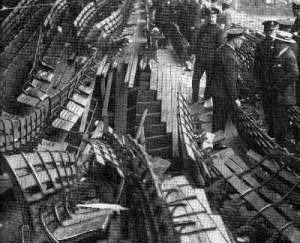
Officials oversee the damage caused by a collapse of the stands at Baker Bowl in 1927. It wasn’t the first time the ballpark’s structure had failed.
A few months into the 1938 season, Phillies owner Gerry Nugent had enough. He finally succeeded in killing the century-long lease on Baker Bowl, freeing him to move his team into Shibe Park, where A’s owner Connie Mack—financially slammed by the Great Depression—was more than happy to collect rent and help fill his coffers. The final game at Baker Bowl provided an apt farewell for years of incompetence; the Phillies were blown out by the New York Giants, 14-1. The loss dropped the Phillies to 16-41 on the season, and a paltry gathering of 1,500 left the decrepit structure relieved that it held for one last time.
After the Phillies left, Baker Bowl limped around for another 12 years, welcoming anyone who dared to use it. Midget auto racing—the cars were midgets, not the drivers—was popular. So was the circus. An ice rink was set up during the winter. Police and fire departments used Baker Bowl for special events. The players’ clubhouse was converted into a nightclub called the Alpine Musical Bar, the door to which still stated, “For Players Only.”
By 1950, Baker Bowl would finally meet the wrecking ball. It was gone and long forgotten by the Phillies, but not by others in the years to come. When the architectural firm HOK Sport told the Baltimore Orioles to keep the B&O Warehouse standing behind the right-field section of Oriole Park at Camden Yards, they might have been influenced by images of Baker Bowl showing the triangular, 10-story Ford Motor Company building rising tall behind the center-field clubhouse; that building remains standing today, boarded up and fenced off as it awaits its own fate.
And what of the site that was once Baker Bowl? A good chunk of it is taken up by an aging warehouse, abutted by a car wash facility. A gas station now sits where the players’ clubhouse once was; next to it is a petite strip mall featuring a Dominos Pizza joint. The only trace of the ballpark that once housed the greatness of Pete Alexander, Gavvy Cravath and Chuck Klein, that witnessed Honus Wagner’s 3,000th hit and Babe Ruth’s last-ever major league appearance, is a historical street sign. It’s a quaint reminder of a ballpark all too briefly considered the greatest in baseball—but all too often remembered as one of its most troubling.
 The Ballparks: Shibe Park In baseball’s landscape of horse buggies and wooden carts, Shibe Park emerged as the Model T of ballparks, a sparkling trendsetter that introduced steel and concrete to the game’s vernacular, beget rooftop entrepreneurs long before Wrigley and brought the game out of its lumbered, fire-cursed squalor. That it stood for generations while two tenants largely stank up the joint was a testament to its perseverance.
The Ballparks: Shibe Park In baseball’s landscape of horse buggies and wooden carts, Shibe Park emerged as the Model T of ballparks, a sparkling trendsetter that introduced steel and concrete to the game’s vernacular, beget rooftop entrepreneurs long before Wrigley and brought the game out of its lumbered, fire-cursed squalor. That it stood for generations while two tenants largely stank up the joint was a testament to its perseverance.
Philadelphia Phillies Team History A decade-by-decade history of the Phillies, the ballparks they’ve played in, and the four people who are on the franchise’s Mount Rushmore.


